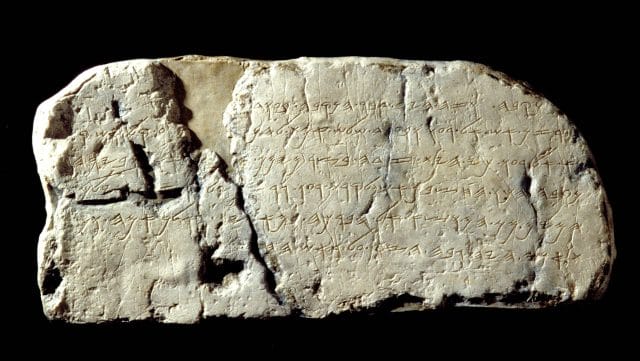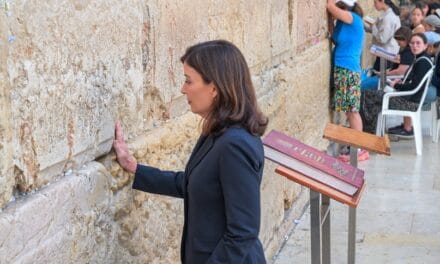By ETGAR LEFKOVITS
(JNS)
An ancient Jerusalem pool that was used by millions of Jewish pilgrims during the time of the Second Temple two millennia ago as a ritual bath before ascending the Temple Mount, and revered by Christians as the site where Jesus cured a blind man, will be fully excavated and then opened to the public, the Israel Antiquities Authority has announced.
Studied For 150 Years
The Pool of Siloam, located in the southern portion of the City of David, the ancient epicenter of Jerusalem, and just outside the Old City walls is expected to become one of the most important historic and tourist sites in the city.

Replica of the Siloam Inscription, the original of which was discovered in the City of David, near the Pool of Siloam. In 1880, the Siloam Inscription was uncovered in the water tunnel, just a few dozen meters from the pool. The Inscription, currently located at the Istanbul Archaeology Museum, is written in ancient Hebrew script and records how the Gihon Spring’s water was diverted to the Pool during the reign of King Hezekiah. Photo courtesy of Ze’ev Radovan, City of David Archives.
The pool has been a focal point for archaeologists and scholars for the last 150 years. The excavations are set to begin in January and will continue for at least several months, while the site is expected to open to the public in about a year.
The City of David, a top tourist attraction in the capital, is adjacent to the eastern Jerusalem neighborhood of Silwan.
The Pool of Siloam was uncovered at the end of the 19th century, when British and American archaeologists led by Frederick Jones Bliss and Archibald Campbell Dickie exposed some of the steps of the pool, followed by some work in the 1960s by the British archaeologist Kathleen Kenyon.
The site’s scope was more fully uncovered only in 2004, when the city Gihon water company was carrying out infrastructure work and a tractor accidentally laid bare more of the location, leading to a partial excavation at the time, said Dr. Amit Re’em, the Jerusalem district archaeologist for the Israel Antiquities Authority.
The well-preserved pool covered with ashlar carved stone was a monumental site, and the consensus in the archaeological community was that this was indeed the Siloam Pool, he said.
The Pilgrimage Road
Moreover, the recently uncovered adjacent stone path, dubbed “the Pilgrimage Road,” which Jewish pilgrims used to ascend the Temple Mount during the Second Temple Period after purifying themselves in water and donning white robes, leads from the pool to the Mount, the Israeli archaeologist said.
This pool was in use during the time of the New Testament’s Jesus, he noted. According to the Gospel of John, it was at the Siloam Pool that Jesus healed the blind man.
What Lies Beneath?
It remains to be seen what lies underneath the pool, and whether an earlier stage of the pool dating back to the First Temple will be found as well, the archaeologist said.
The Pool of Siloam was constructed as part of Jerusalem’s water system during the reign of King Hezekiah (715–687/6 BCE), as described in 2 Kings 20:20.
It served as the reservoir for the waters of the Gihon Spring, which were diverted through an underground water tunnel, and was one of the most important areas in Jerusalem in the First Temple period, the Antiquities Authority has reported. Due to its location and importance, the Pool of Siloam was renovated and expanded some 2,000 years ago, at the end of the Second Temple period.
Legal Battle Ends
The planned excavation of the five-dunam site (about 1.25 acres) is underway after a 14-year legal battle culminated in June when Israel’s Supreme Court found no reason to challenge the validity of the Ateret Cohanim organization’s purchase of 99-year leases, renewable for an additional 99 years, from the Greek Orthodox Church, the largest landowner in Jerusalem.
One of Ateret Cohanim’s goals is to purchase land in the history-rich area for public viewing, said Doron Spielman, vice president of the City of David Foundation. Previously, the area, which was off limits to everybody, lay barren for decades and was littered with garbage, he said.
“It is not every day that we find an icon in Jerusalem,” Spielman said. “This is not just a huge find, it is a mega-find.”
Tourism Draw
Jerusalem Mayor Moshe Lion said in a statement, “The Pool of Siloam in the City of David National Park in Jerusalem is a site of historic, national and international significance. After many years of anticipation, we will soon merit being able to uncover this important site and make it accessible to the millions of visitors visiting Jerusalem each year.”
One million visitors visited the City Of David in 2019, before the outbreak of the coronavirus, and three million are expected next year with the launch of a cable car, said Oriya Dasberg, head of physical development at the City of David Foundation.
“The same way that this pool drew pilgrims thousands of years ago—on the path of our ancestors—it will now attract millions of tourists,” she said.








